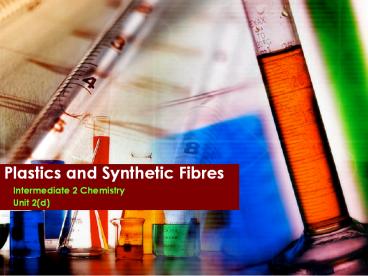Plastics and Synthetic Fibres PowerPoint PPT Presentation
Title: Plastics and Synthetic Fibres
1
Plastics and Synthetic Fibres
- Intermediate 2 Chemistry
- Unit 2(d)
2
Examples of plastics
3
Examples of plastics
- Polythene poly(ethene)
- Polystyrene
- Perspex
- PVC
- Nylon
- Bakelite
- Formica
- Silicones
4
PVC poly(vinyl chloride)
5
Nylon
6
Bakelite
7
Formica
8
Silicones
9
Where do plastics come from?
- Crude oil
- Fractional distillation
- Cracking
- Alkenes
10
Uses related to properties
- Flexible
- Watertight
- Shatter-proof
- Light
11
Non-biodegradable
- Cant be broken down by living things.
- Biopol is a recently developed biodegradable
plastic.
12
Other problems with plastics
- Low density
- Durable
- Burn or smoulder to give off toxic fumes
- Carbon monoxide
- Hydrogen chloride
- Hydrogen cyanide
13
Types of plastic
- Thermoplastic
- Can be reshaped on heating
- Thermosetting plastic
- Cannot be reshaped on heating
14
Chemistry of plastics
- Plastics are examples of polymers
- These are long chain molecules made from smaller
molecules joining together - These smaller molecules are called monomers
- There are two types of polymer
- Addition polymer
- Condensation polymer
15
Addition polymers
16
Addition polymers
- Like all polymers, these are made from monomers.
- For an addition polymer, these monomers always
have a CC - These join together in a reaction called addition
polymerisation. - view animation
17
1
2
3
MONOMERS
POLYMERS
18
1
3
2
3
1
2
MONOMERS
POLYMERS
19
(No Transcript)
20
Naming polymers
- The name of the polymer is made by taking the
name of the monomer, putting brackets around it,
and adding poly in front - Poly(ethene) is made from ethene
- Poly(vinyl chloride) is made from vinyl chloride.
21
Naming practice
- Name the polymer made from
- Propene
- Chloroethene
- Name the monomer used to make
- Poly(heptene)
- Poly(phenylethene)
22
Drawing polymers, monomers and the repeating unit
23
CC
H
H
H
H
H
H
C6H5
H
C6H5
H
C6H5
H
Poly(phenylethene)
24
(No Transcript)
25
Condensation polymers
26
- What type of molecule is produced from an alkanol
and alkanoic acid? - Esters
- Polyesters are made from similar molecules.
27
Polyesters
28
Monomers
- Must have two functional groups per molecule
- For polyesters, they are a diol and a diacid
29
Condensation polymerisation
- The joining up of two molecules, producing water,
is condensation. - Because giant molecules are made, this is
condensation polymerisation. - Specifically with a diol and a diacid, a
polyester is produced.
30
Polyamides
- Are produced when an amine group reacts with a
carboxyl group.
31
(No Transcript)
32
Amides
- Formed when an amine reacts with an alkanoic acid.
amide
amine
carboxylic acid
33
Polyamides
- Are condensation polymers.
- Formed when a diamine reacts with a diacid.
34
Recently developed plastics
- Kevlar
- Very strong
- Poly(ethenol)
- Water soluble
- Biopol
- Biodegradable
35
Kevlar
36
Kevlar
37
Poly(ethenol)
38
Poly(ethenol)
39
(No Transcript)

